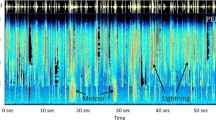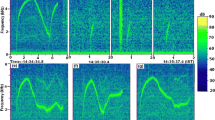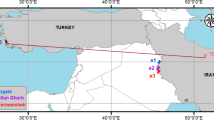Abstract
For a long time, the generation mechanism of simultaneous sound with passing of large meteors was a research edge until a reasonable mechanism was proposed for that. This mechanism is based on the existence of ELF/VLF radio signals. This research that aims for detection of these signals archives an improvement over previous works. The signal was found on the extremely low frequency (ELF) band which could not be generated by other sources like lightning, has a frequency range between several Hertz to 500 Hz, and so could be missed with noises produce by electrical machines. The new signal is presented at this work has a good correlation with synchronized visual data that were collected on the peak of Geminids 2011 meteor shower.
Similar content being viewed by others
1 Introduction
An anomalous sound (electrophonics) which is heard at the time of passing large meteors was a mystery for over two centuries. Observers of this strange phenomenon have reported that they had heard a “hiss” sound simultaneously while observing large meteors in the sky. Because there is no time delay interval between observation and sound, source of electrophonics could not be meteor’s shockwave. A viable physical explanation was developed after it was verified that plasma tail of meteor could generate extremely low frequency (ELF) to very low frequency (VLF) electromagnetic (EM) radiations that reach the earth’s surface at the same instance as the optical signals (Keay 1980). The electric field of these EM waves can make conductive materials around observers to vibrate and produce acoustic sounds. The production of electrophonics solely depends on the conversion factor of the transducers present near the observer, and in many cases no electrophonics is generated. As a result, electrophonics is not always reliable for meteor shower detection (Guha et al. 2009). A significant amount of research is done on these ELF/VLF signals in the past two decades verifying the validity of this hypothesis and explaining the properties of the emitted EM wave and the conditions in which the electrophonic sound is heard (Keay 1992, 1993, 1995; Beech et al. 1995; Beech and Foschini 2001; Zgrablic et al. 2002; Chakrabarti et al. 2002).
Meteors are not the only source of ELF/VLF waves. High-intensity EM waves are also produced in this band by other sources; among them, we can mention lightning, electrical circuits, and power supplies in households and machinery. Therefore, any detection of the meteor signal in this spectrum segment is highly contaminated by noise and interference. Lightnings have impulse-like signals called radio atmospherics or sferics (Fig. 1), which are guided over long distances (Cummer et al. 1998). The estimation is that about 2000 thunderstorms are in progress around the world at any moment. Its global flash rate is of order 100 per second (Orville and Spencer 1979). ELF/VLF waves which are radiated near the ground are reflected by the lower ionosphere and the ground, and thus they are propagated in a guided path between the two boundaries. This path is known as Earth-ionosphere waveguide by which ELF/VLF waves which are guided through several thousand of kilometers paths around the globe. The attenuation that happens to EM wave propagation through Earth-ionosphere waveguide is extraordinarily small in the lower ELF band. Its magnitude is only 0.3 dB/1000 km at 10 Hz, increasing with frequency to about one dB/1000 km at 60 Hz (Barringer and Hart 1949; Volland 1982; Watanabe et al. 1988; Keay 1990; Barr et al. 2000; Price and Blum 2000; Cohen et al., Awesome monitor).
2 Review and Analysis of Related Work
The first attempt to prove the possibility of radio emissions by meteors was that of Hawkins (1958a, b). He commented that meteors showed a surprisingly low efficiency in converting kinetic to radio energy. Watanabe et al. (1988) have described the detection of meteor-generated VLF from a bright Perseid fireball (M ≈ −6) observed in 1981. Drobnock (1992) has also suggested that the meteors as faint as M ≈ +1 can generate VLF emissions.
The first detailed investigation into recording the VLF signals from meteors was done by Martin Beech and Peter Brown. They had two goals for their experiments. Their first attempt was for recording the ordinary meteors’ VLF signals, but they have failed to verify Drobnock’s observations. They believed that Drobnock has confused natural VLF radio background for meteor’s signals. It is important to realize that VLF radio emissions are continually generated in the Earth’s ionosphere. As the second goal, they aimed to record the VLF signals produced by uncommon and bright fireballs. Finally they could record a clear and convincing VLF signal from a large fireball with the visual magnitude −10 ± 1 at 19:57:32 UT August 11, 1993 from Puimichel, in Southern France. They had observed many meteors in the magnitude range of −11 to +4, and they suggested that fireballs fainter than M ≈ −10 ± 1 are not likely to generate VLF emissions (Martin Beech et al. 1995).
Also, C. Price and M. Blum group performed six hours of continuous ELF/VLF signal recording from 21:30 UT on the November 17 to 03:30 UT on the November 18, 1999 during the Leonid meteor shower peak time. They presented some differences between lightning and meteor signals that they had observed. “First, since the lightning pulse lasts no longer than 1 ms, the meteor pulse continues for up to 10 ms. Although this is longer than the lightning pulse, it is much shorter than the duration of the optical meteor trail which can last for seconds. Second, the amplitude of the lightning pulse is much larger than that of meteor pulse” (C. Price and M. Blum). They marked the meteors signals with a large maximum in the ELF range below 2 kHz, where the lightning’s is the weakest.
As depicted in these spectrums (Fig. 2), they used 1.2 kHz frequency to automatically identify the presence of a meteor in dynamic spectrum because it is exactly where the lightning signal is the weakest. By using the specified threshold of the signal amplitude at 1.2 kHz, they counted the number of meteor signals. As a result of using the ELF/VLF method of counting the meteor flux, they recorded a peak of 15,000 per hour, relative to 350 per hour via optical methods. The ELF/VLF method detected nearly 50 times more meteors than the optical method.
3 Recording Setup
The setup used during ELF/VLF signal recordings consisted of an electrically small (Stutzman and Thiele 1998) omnidirectional loop antenna, a set of amplifiers with adjustable gain, and an embedded device for recording the ELV/VLF signals and capturing the time of observed meteors with common timing mechanism. The recordings were carried out in successive duration sets of 30 min with the higher band limit of 24 kHz. The antenna was 7 m high and consisted of two orthogonal loop antennas. Each loop was a square with 3 m side length facing, respectively, north–south and east–west. For maximal power flow from antenna through the amplifier circuit, the input impedance of the amplifier was designed to match the antenna.
The output signal of the amplifier then passed the embedded recorder. This embedded system recorded the signal with 16 bit/sample resolution and 48,000 samples per second for each antenna. It also captured the time of the observed meteors by buttons in the hand of eight trained observers. If any observer saw a meteor, he/she would press his/her button instantly, commanding the embedded recorder to pinpoint the time of the recording with the presence of a meteor signal.
These data would later become useful for determining the time domain and spectral properties of meteor signals. As we did not expect to observe all the meteors signal that had been recorded, known properties would become useful to pinpoint all the recorded meteors.
4 Results
The first signals detected in the ELF/VLF band are the lightning pulses, because they generate high-intensity vertical lines in dynamic spectrum, and they have three different types based on their distances (Morris B. Cohen et al.). The other types of ELF/VLF signals such as natural noise (hiss and chorus) are clearly different from meteors in their amplitude level and time duration. The signals which can be mistaken with meteor signals are the three types of sferics. The first type is near lightning signals called pops. They produce bulk vertical lines with almost the same amplitude between 0 and 14 kHz frequency range (Fig. 3). The second type is the lightning signals which are received from about 1000 km. Because of the differences between phase and group velocity for frequencies near 1.8 kHz, a sort of tail is generated on these vertical lines. These types of lightning signals are known as “tweeks” (Fig. 3). The third type is known as clicks, and they are background signals which are received from lightning all over the world from far distances. Although these EM waves can spread all over the world through the Earth-ionosphere waveguide, they get weaker in amplitude after traveling long distances. The largest attenuation of signal happens near 2 kHz frequency and decreases for both lower and higher frequencies at the same rate, so for the lightning signals which are detected from far away, the middle part of signals between 1 and 5 kHz disappears (Fig. 3). The average spectrum of a lightning signal is shown in Fig. 1. It shows that all types of lightning signals have high amplitude in frequencies interval of 5–8 kHz.
Our goal was to find a kind of signal in the ELF/VLF band that has three properties. Firstly it should not be similar to other signals that were known in this bandwidth like different types of lightning signals. Secondly it should be a random pulse through the time, and thirdly it should have some correlations with observed data which we recorded at the experiment site.
We conducted our experiment in the predicted peak night of Geminids shower at December 14, 2011 in the Desert Camp of Shahdad (30.58 N; 57.85 E) near to Kerman, Iran, and these data were captured from 20:00 to 20:20 (local time) at the best time before moon rise. The Geminids meteor shower was used because they are rather slow meteors (V ~ 35 km/s), they are produced by high-density meteoroids, and this enhances their atmospheric survival to lower altitudes, which according to the current theoretical models favors ELF/VLF generation indeed, the Geminids are favored more than the much faster November Leonid meteors which were tested by C. Price and M. Blum group and because the shower has consistently higher meteor rates each year. After analyzing experimental data, a kind of signal was found that had the properties. Although it has some similarity to the signals which are presented in previous works, but there are some significant differences.
Different characteristics of meteor signals help us to recognize them from the others in this bandwidth. Spectrum of meteor signals range from several Hz to 2 kHz (Fig. 4), but a lightning signal ranges up to 14 kHz. Because meteor signals are interfered with high-amplitude electrical power line noises, they could have been missed or mistaken in the previous works. The maximum amplitude of a meteor signal is between 400 and 500 Hz (Fig. 4); however, lightning’s highest amplitude is between 5 and 8 kHz (Fig. 1). Meteor signals durations in their times are random and can be as long as 8 ms, but lightning signals are not longer than 1 ms. The power line ELF/VLF signals and their harmonics have known frequency range, and they have almost the same amplitude level in each times duration. The selected location for the experiment was far from power lines; therefore, we had the lowest noise level in our data. The meteor signals can be easily separated from background because they are at the higher amplitude level which is clear on Fig. 4.
A graph comparing ELF/VLF signals and optical data of the experiment is presented in Fig. 5. The count of signal for every minute of the ELF/VLF data is compared to the count of meteor which was seen by the observers at that minute. The correlation between these two graphs verifies the connection between the signal and the meteors that had penetrated earth atmosphere.
The number of signals is more than observed meteors at the same duration because some meteors would not be seen but their signal is received by the antenna. As Fig. 5 shows, each graph has five maximum numbers that occurs at almost the same time for both graphs. This is due to rising in meteor income which may have a time delay on some parts because the Geminids shower radiant is not at zenith position for the observation location, so there are some meteors which appeared under our horizon, but we still have their ELF/VLF signals. The synchronized visual observation was done at the same place where the antenna was assembled by a trained group of amateur astronomers. The data on meteor magnitude estimates in 20 min are presented on Table 1.
5 Conclusions
The ELF/VLF detection is a method with good accuracy for meteor researches, but the main disadvantage is that the signal which generated is at a noisy frequency band. The accuracy of meteor counting by this method has a close connection to the ability with distinguish and separate the meteor signals from others at this band. There was not a significant characteristic of meteor signal which has an acceptable correlation with visual data. We presented a signal that has meaningful correlation with our visual data that was collected near our antenna. We still cannot link each signal to its meteor parent, but the correlation of the signals and incoming meteors are obvious. It needs more practical work in the future to find the characteristic of meteors such as their mass, velocity, direction, and other factors by their ELF/VLF signals.
References
R. Barr, D.L. Jones, C.J. Rodger, J. Atmos. Sol. Terr. Phys. 62, 18–1689 (2000)
B. Barringer, H.C. Hart, The mechanism of sounds from meteors. Contrib. Meteorit. Soc. 57, 507–512 (1949)
M. Beech, L. Foschini, Astron. Astrophys. 367, 1056 (2001)
S.K. Chakrabarti, S. Pal, K. Acharya, S. Mandal, S. Chakrabarti, R. Khan, B. Bose, Indian J. Phys. 76B, 6–693 (2002)
M.B. Cohen et al., “Remote Sensing of the Lower Ionosphere and the Radiation Belts with AWESOME and SID ELF/VLF Receivers,” Star.tanford.edu/~vlf/awesome.html (Awesome monitor)
S.A. Cummer, U.S. Inan, T.F. Bell, Ionospheric D region remote sensing using VLF radio atmospherics. Radio Sci. 33, 1781 (1998)
G.J. Drobnock, Sky and Telescope 77, 329–331 (1992)
A. Guha, B.K. De, R. Roy, Earth Moon Planets (2009). doi:10.1007/s11038-009-9304-0
G.S. Hawkins, Nature 181, 1610 (1958a)
G.S. Hawkins, Ap. J. 128, 724 (1958b)
C.S.L. Keay, Science 210, pp. 11–15 (1980)
C.S.L. Keay, Chant CA and the mystery of auroral sounds. J. Roy. Astron. Soc. Can. 84, 373–382 (1990)
C.S.L. Keay, Electrophonic sounds from large meteor fireballs. Meteorit. J. 27, 144–148 (1992)
C.S.L. Keay, J. Sci. Explor. 7, 337 (1993)
C.S.L. Keay, Earth Moon Planets 68, 361 (1995)
Martin Beech et al., VLF detection of fireballs. Earth, Moon Planets 68, 181–188 (1995)
R.E. Orville, D.W. Spencer, Global lightning flash frequency. Mon. Weather Rev. 107, 934–943 (1979)
C. Price, M. Blum, ELF/VLF radiation produced by the 1999 Leonid Meteors. Earth Moon Planets 83, 5451–5554 (2000)
W.L. Stutzman, G.A. Thiele, Antenna Theory and Design, 2nd edn. (Wiley, New York, 1998)
H. Volland, Handbook of Atmospherics (CRC Press, Boca Raton, 1982), pp. 179–250. Fla
T. Watanabe, T. Okada, K. Suzuki, Meteor and radio wave. HAM J. 54, 109–115 (1988)
G. Zgrablic, D. Vinkovic, S. Gradecak, D. Kovacic, N. Biliskov, N. Grbac, Z. Andreic, S. Garaj. J. Geophys. Res. 107, 1124 (2002). doi:10.1029/2001JA000310
Author information
Authors and Affiliations
Corresponding author
Rights and permissions
About this article
Cite this article
Lashkari, A.K., Zeinali, M.M. & Taraz, M. Detecting of ELF/VLF Signals Generated by GEMINIDS 2011 Meteors. Earth Moon Planets 115, 23–30 (2015). https://doi.org/10.1007/s11038-015-9463-0
Received:
Accepted:
Published:
Issue Date:
DOI: https://doi.org/10.1007/s11038-015-9463-0









